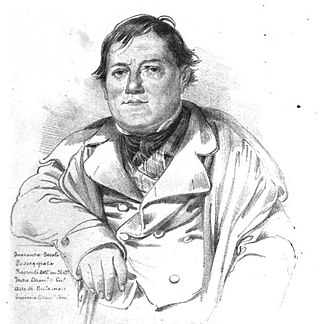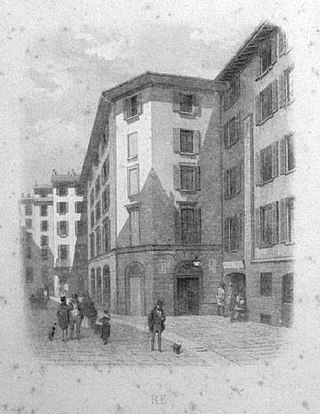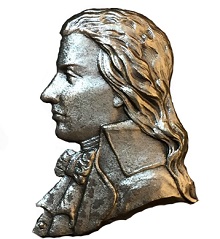Related Research Articles
Giuseppe Farinelli was an Italian composer active at the end of the 18th century and the beginning of the 19th century who excelled in writing opera buffas. Considered the successor and most successful imitator of Domenico Cimarosa, the greatest of his roughly 60 operas include I riti d'Efeso, La contadina bizzarra and Ginevra degli Almieri. More than 2/3 of his operas were produced between 1800-1810 at the height of his popularity. With the arrival of Gioachino Rossini his operas became less desirable with the public, and by 1817 his operas were no longer performed. His other compositions include 3 piano forte sonatas, 3 oratorios, 11 cantatas, 5 masses, 2 Te Deums, a Stabat mater, a Salve regina, a Tantum ergo, numerous motets, and several other sacred works.

Carlo Francesco Pollarolo was an Italian composer, organist, and music director. Known chiefly for his operas, he wrote a total of 85 of them as well as 13 oratorios. His compositional style was initially indebted to the opera tradition of Giovanni Legrenzi and Carlo Pallavicino, but he moved beyond this style with innovations to the compositional structure of the aria characterized by expanded forms and orchestral elaborations. His early work used three part strings in the Legrenzi and Pallacino tradition of orchestration, but his mid and later works had developed into a richer orchestration of five strings parts and expanded instrumentation of brass and woodwinds. He was the first Venetian opera composer and one of the earliest Italian composers to use the oboe in his opera orchestrations.
Giuseppe Lillo was an Italian composer. He is best known for his operas which followed in the same vein of Gioachino Rossini. He also produced works for solo piano, a small amount of sacred music, and some chamber music.
Carlo Franchi was an Italian opera composer known for his opere buffe. He belonged to the Neapolitan school of composers and it is likely that he was born in or near Naples, where his first opera La vedova capricciosa had its premiere in 1765. Subsequent works were performed in Rome, Venice, Mantua, Turin, Florence, and outside Italy in places such as Dresden and Lisbon.

Antonio Cagnoni was an Italian composer. Primarily known for his twenty operas, his work is characterized by his use of leitmotifs and moderately dissonant harmonies. In addition to writing music for the stage, he composed a modest amount of sacred music, most notably a Requiem in 1888. He also contributed the third movement, Quid sum miser, to the Messa per Rossini, a collaborative work created by thirteen composers to honor Gioacchino Rossini.
Giovanni Schmidt was an Italian librettist.

Teatro San Samuele was an opera house and theatre located at the Rio del Duca, between Campo San Samuele and Campo Santo Stefano, in Venice. One of several important theatres built in that city by the Grimani family, the theatre opened in 1656 and operated continuously until a fire destroyed the theatre in 1747. A new structure was built and opened in 1748, but financial difficulties forced the theatre to close and be sold in 1770. The theatre remained active until 1807 when it was shut down by Napoleonic decree. It reopened in 1815 and was later acquired by impresario Giuseppe Camploy in 1819. In 1853 the theatre was renamed the Teatro Camploy. Upon Camploy's death in 1889, the theatre was bequeathed to the City of Verona. The Venice City Council in turn bought the theatre and demolished it in 1894.
Domenico Gilardoni (1798–1831) was an Italian opera librettist, most well known for his collaborations with the composers Vincenzo Bellini and Gaetano Donizetti.
Pierantonio Tasca (1858–1934) was an Italian opera composer. His first opera, Bianca, premiered in 1885, to a libretto by Enrico Golisciani. Eva Tetrazzini, elder sister of the famous Luisa Tetrazzini participated in the premiere.

Carlo Curti was a Bolognese Italian cellist, educator and composer. He studied violin under Rolla, and then the cello under Parisini. He was made professor at the Liceo di Musica as a young man and in May 1838 became First Cello in the Teatro Regio in Parma when it was led by Nicola De Giovanni. He retired to Bologna, his home town and birthplace, in 1871 or 1872 and died from a cardiac condition caused by pneumonia soon after. The 17 May 1838 issue of the music journal Teatri Art E Letteratura pointed to him as him an example of Italian musical excellence, a gift to the world.

Artaserse is an opera in three acts composed by Johann Adolph Hasse to an Italian libretto adapted from that by Metastasio by Giovanni Boldini first shown in Venice on 11 February 1730. Artaserse received its modern day premiere by Ensemble Serse in London on 7 November 2009.
Giacomo Maccari was an Italian opera composer.

Telemaco, ossia L'isola di Circe is a 1718 opera by Alessandro Scarlatti to a libretto by Carlo Sigismondo Capece, court poet to Queen Maria Casimira of Poland, living in exile in Rome, for the Teatro Capranica in Rome, where it was premiered during the carnival season. The opera was revived in 2005 by the Schwetzingen Festival and the Deutsche Oper am Rhein.
Giuseppe Balducci was an Italian composer, primarily of operas. Born in Iesi, he spent most of his career in Naples and was one of the originators of the "salon opera" genre, the forerunner of chamber opera.

Nicola De Giosa was an Italian composer and conductor active in Naples. He composed numerous operas, the most successful of which, Don Checco and Napoli di carnevale, were in the Neapolitan opera buffa genre. His other works included sacred music and art songs. His songs were particularly popular, bringing him fame as a salon composer both in Italy and abroad. De Giosa died in Bari, the city of his birth, at the age of 66.
Giuseppe Puzone was an Italian opera composer and conductor active in Naples, the city of his birth. He was for many years the principal conductor of the Teatro San Carlo where his opera Elfrida di Salerno had premiered in 1849. He composed three other operas, all of which premiered in Naples, as well as sacred and symphonic music.

Giovanni Emanuele Bidera was an Italian writer.

The Teatro Re was a theatre in Milan, located near the Piazza del Duomo and named for its proprietor, Carlo Re. It functioned as both a prose theatre and an opera house and saw the world premieres of numerous operas, including four by Giovanni Pacini. Designed by Luigi Canonica, the theatre was inaugurated in 1813, closed in 1872, and demolished in 1879.

Luigi Capotorti was an Italian composer of both sacred and secular music. He was the maestro di cappella of several Neapolitan churches; the composer of ten operas, five of which premiered at the Teatro San Carlo in Naples; and a teacher of composition and singing whose students included Stefano Pavesi and Saverio Mercadante. Born in Molfetta, he studied violin and composition at the Conservatorio di Sant'Onofrio in Naples and spent his entire career in that city. In his later years, Capotorti retired to San Severo, where he died at the age of 75.
References
- ↑ Ricerche su l'origine, su i progressi, e sul decadimento delle arti, 1821, by Giovanni Battista Gennaro Grossi, page 30.
- ↑ For a performance, Antonio Niccolini was the architect, Angelo Belloni, main scenographer, Gaetano Sandri and Niccolo Pellandi were the painters of architecture, Leopoldo Galluzi painted landscapes, and Giuseppe Morrone, ornaments. Le Nozze Campestri, Dramma per Musica in un Atto. Presented in Royal Theater San Carlo May 30, 1841 in honor of the birthday of the King, by Giovanni Schmidt, Biblioteca Caproni Dalla Tipografia Flautina (1841), page 5.
- ↑ Gonzalvo: Melodramma serio in 2 atti. Teatro San Carlo, by Felice Romani, page 3.
- ↑ Rolla: Melodramma in due atti. Teatro San Carlo, Page 3.
- ↑ Oberto: Dramma tragico per musica, in 2 atti, by Giacomo Sacchéro (1841), Page 5.
- ↑ Il ravvedimento: melodramma in tre atti, page 3.